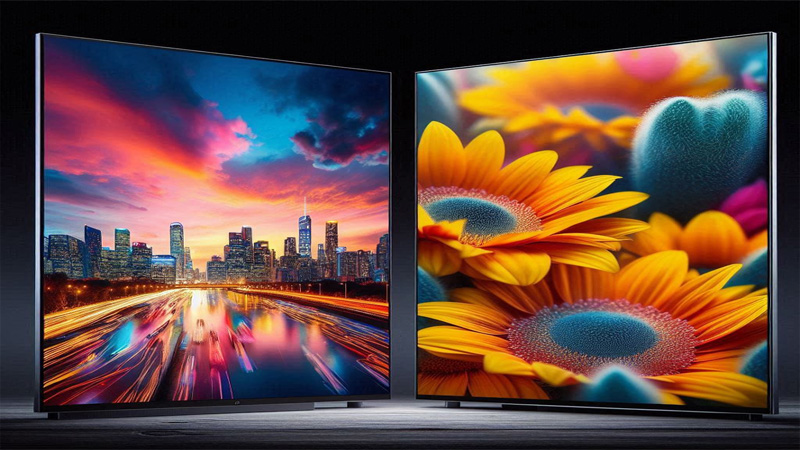LCD Display Vs OLED Screen: Comprehensive Comparison Guide
Choices between LCD and OLED displays are not only a matter of quality. Rather, it is about clarity, color, and how your screen handles light. Each has something quite different to offer. This article will point out the relative strengths of both and their differences for making the best choice.
1. What is LCD and OLED?
LCD means Liquid Crystal Display. These liquid crystals block and allow light to pass through to generate colors and images. LCDs are very bright, yet very energy-efficient. Hence, they find good applications on TVs, computer monitors, and even smartphones. OLED is different. It is an organic light-emitting diode technology that sees every pixel in the screen emit its own light.
That means no backlight, hence much deeper blacks, richer colors, and better contrast. A pixel that is turned off is actually completely black, which makes OLED ideal for when it comes to showing high-quality videos. They are in high-end TVs, premium phones, and even some laptops.
2. LCD vs. OLED: Multi-dimensional Comparison
-
2.1 Image Quality Comparison
LCD and OLED screens come with their respective advantages concerning image quality depending on different lighting conditions. Where LCDs really shine is in terms of brightness. In very bright rooms, the LCD display truly shines. The backlighting on the display makes all the content visible even when the sun is beating down on it.
It tends to struggle with color accuracy, though. On an LCD, blacks look more like dark gray because of that same backlighting, which means contrast ratios don’t quite reach OLED standards.
Against that, OLEDs allow for dynamic colors and perfect blacks due to their pixel-by-pixel lighting. In other words, each pixel lights itself, which allows for amazing contrast and deep blacks. Hence, allowing colors to really pop. This gives OLED an edge in darkened rooms and an immersive experience full of vivid and natural colors.
Also, you get radiant colors and details from almost any angle. While LCDs tend to wash out when viewed unless straight on. In other words, in situations where brightness and reliability in bright lights are required, LCDs are fine. For those who desire a visual feast of life-like colors, deep blacks, and wider viewing ranges, OLED is pretty stunning.
-
2.2 Energy Efficiency
Energy efficiency remains the significant deciding factor between LCD and OLED. While both forms of displays have their own strengths. They deal with power differently, which impacts your battery life and your energy bills.
-
2.2.1 Power Consumption
So, the thing with LCDs is that they use a backlight that’s always un-even when large parts of the screen are dark. That just means it’s eating up power, no matter what’s on the screen. The difference with OLED is this: each pixel lights up for itself. When the screen shows dark areas, hardly any energy will be used. Whenever you watch content with more sober scenes or activate dark mode, OLED saves you power.
-
2.2.2 Why Energy Efficiency Matters
Lower consumption, of course, also means longer battery life in your portable smartphones or laptops. This is extremely critical if you have to be on the go with no definite places to plug into. Secondly, huge amounts of energy can be saved on a very large OLED display running for several hours continuously. The sum of this energy saved contributes to a reduction in the use of electricity over time.
-
2.2.3 Which Devices Benefit Most?
- Smartphones and Laptops: If you like the dark theme or do a lot of reading. Then with OLED’s pixel-by-pixel control. You would have to charge your gadget less frequently.
- Creative Work Monitor: This would be good enough. The same consistency in brightness across all colors is helpful to designers doing graphics or video editing.
- TVs for Dimly Lit Rooms: OLED is great when it comes to dim or completely darkened rooms. It provides bright visuals without consuming a lot of energy.
- Outdoor displays: LCDs are better in bright environments. It is more readable under direct sunlight and uses comparable energy for high-brightness settings.
Which one is better out of the LCD and OLED? That depends on your use case. How, where, and how frequently you’re using your device. Whether you need to save power and maximize your battery life. Then it’s a sure choice to go with OLED. But if you need your display to stay steady and bright no matter what’s on screen. Then LCD’s your best bet.
-
2.3 Longevity and Durability
LCD monitors are also pretty robust. Due to the use of backlight. They usually may work a little longer-around 50,000-100,000 hours with slight deterioration. OLED monitors have a bit worse case. On average, they can show about 20,000-50,000 hours. Why? It is all about technology. OLED pixels emit their light and degrade naturally over time.
And most susceptible to aging is a blue pixel, which ages much faster than the rest. But that shouldn’t scare you away. For the majority of users, an OLED screen is still going to last several years much longer
-
2.3.1 Factors Affecting Longevity
- Brightness Settings: The screen running at maximum brightness affects the longevity negatively. For both LCD and OLED, with the latter again taking most of the brightness.
- Usage Patterns: If you’re going through dynamic content for example, movies or games with lots of action. Then your screen will go through less wear. But if you leave static images on screen for extended periods. You’re speeding up the wear, especially on OLED.
- Temperature: Extreme heat will shorten the life of both screen types. In an OLED, it aids in faster degradation of pixels. The display should be kept away from direct sunlight and high temperatures to prolong its life.
-
2.3.2 Burn-In Issues: An OLED Screen Problem
One common concern with OLED is screen burn-in. That’s when static images, such as a logo or status bar, remain on the screen for a very long period. Those static images can “burn” into the screen over time, faint ghostly images visible. For gamers or those who leave their screens on the same channel. This can be a significant issue.
You can prevent burn-in by:
- Lowering screen brightness
- Using screen savers
- Rotation of content to prevent static display of still images
-
2.3.3 Durability: LCD vs. OLED
Speaking of durability, LCDs will surely win. Because they employ backlighting. The LCD screen is more resistant to wear and tear, and daily impact can be withstood without easily showing wear. As strong as OLEDs are when it comes to the brilliance of color. They are weak. They make use of organic materials that can deteriorate over time. Also, they can easily be damaged by impact or pressure.
-
2.3.4 Which Should You Choose?
Go for LCD if it is the longevity and durability you want. LCD is a steady performer. Prone less to wear and tear, and generally cheaper. But if you’re into cinematic viewing with wild colors and deep blacks, OLED will be worth the buck.
3. Cost of Analysis
The difference between LCD and OLED is not only in quality when buying displays but also in cost. And this cost difference shapes product pricing. Hence affecting what you pay as a consumer and what manufacturers pay to make each unit.
LCDs tend to be cheaper. They have been out for a longer period. The manufacturing process is more established. Thus, fewer production costs for the manufacturers. While the OLED displays introduce very good colors and deeper blacks. All this comes at a price: newer, more complicated to make. Thus it requires special materials and processes that raise costs.
LCDs are cheaper to produce for regular devices. You’ll find these in budget TVs, smartphones, and monitors. But if you want that tantalizing color and energy efficiency that OLED gives. Then you can bet it will cost more. OLED has a tendency to show up in higher-end devices. It’s also more expensive to manufacture. The increased production cost then gets passed on to you, the customer.
It’s all about priorities in the end. You’ve got an affordable and reliable LCD or a superior viewing experience with a premium on OLED. Knowing cost differences between these will better prepare you for the decision you have to make.
4. Applications
You’ll prefer LCDs for:
- Brightness: LCDs are brighter; hence, they are perfect to work outdoors or in well-lit areas.
- Economy: LCDs are cheaper to make and buy.
- Longevity: LCDs are very durable. They last longer and are susceptible to burn-in.
Some of the industries that rely on LCDs are:
- Retail: LCDs brighten up shop windows to showcase products.
- Education: Affordable LCDs provide classrooms with an interactive display.
- Gaming: LCDs’ fast response time suits casual gaming.
You’ll prefer OLEDs for:
- Contrast: True blacks with OLEDs give an immersive experience.
- Color Accuracy: With OLEDs, colors are vibrant and true.
- Energy Efficiency: Power consumption in OLEDs is low.
Industries where OLEDs are used:
- Cinema: OLED gives cinematic quality in filmmaking.
- Gaming-Pro: Fast response time and HDR support enthusiast gaming on OLEDs.
- High-End Smartphones: OLEDs upgrade mobile visuals.
Consumer Segments
- Home Entertainment: OLED works for home theaters and gaming setups.
- Graphic designing: The color accuracy of OLEDs is useful to the creative professional.
Outdoor workers: LCD brightness will ensure that doing their job outdoors, like construction workers or delivery people, will be easier.
![]() Front-end Convenient Maintenance
Front-end Convenient Maintenance
![]() Cabinet Size: 640*480mm/3:2 Ratio
Cabinet Size: 640*480mm/3:2 Ratio
![]() Compatible with 320*160mm Module
Compatible with 320*160mm Module
![]() With 3 Years Warranty and 5% Spare Parts
With 3 Years Warranty and 5% Spare Parts
![]() Front Convenient Maintenance
Front Convenient Maintenance
![]() Hard Connection, No Need Cables
Hard Connection, No Need Cables
![]() Can Removable Back Power Supply Box
Can Removable Back Power Supply Box
![]() With 3 Years Warranty and 5% Spare Parts
With 3 Years Warranty and 5% Spare Parts
5. Bottom Line
The bottom line of the difference between LCD and OLED is a question of what you want most. Whatever the case is, now you’re ready to decide. Weigh the benefits with your needs and make the choice that best suits you. The perfect display is within reach.
Contact
 Building D, Hongfa Science Park,
Building D, Hongfa Science Park,
2035 Songbai Road, Shiyan, Bao’an District, Shenzhen, Guangdong, China.






